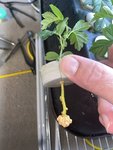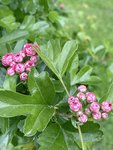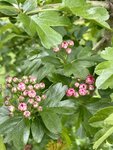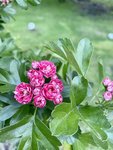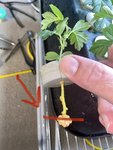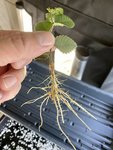You are using an out of date browser. It may not display this or other websites correctly.
You should upgrade or use an alternative browser.
You should upgrade or use an alternative browser.
Whats the deal heavy callus
- Thread starter cmeg1
- Start date
sorce
Nonsense Rascal
I'd investigate gall. Or Rust.
That one's gonna be rich, he's a baller.
Sorce
That one's gonna be rich, he's a baller.
Sorce
cmeg1
Imperial Masterpiece
Cadillactaste
Neagari Gal
To me that looks like gall to me as well... I've had it in a landscape shrub. I dug it up and burnt it. I hope your others are okay.
cmeg1
Imperial Masterpiece
@Cadillactaste
@sorce
Thanks..that is actually callus formation ...a precurser to rooting.......or in some cases a hinderance.........these are completely healthy
Trying to figure why no roots....
@sorce
Thanks..that is actually callus formation ...a precurser to rooting.......or in some cases a hinderance.........these are completely healthy
Trying to figure why no roots....
Cadillactaste
Neagari Gal
That is really interesting...it so looks like gall. Sorry, I of course have no experience with propagation...so...as you can see, where I fumbled the ball on this aspect. Maybe Brent can offer you some direction. IF you are on Facebook...Mark Comstock may also be of some knowledge in that aspect...as well as @William N. Valavanis does propagation...so maybe there as well. Those are the only ones I know...do mass propagation. Along with who you already tagged.@Cadillactaste
@sorce
Thanks..that is actually callus formation ...a precurser to rooting.......or in some cases a hinderance.........these are completely healthy
Trying to figure why no roots....
cmeg1
Imperial Masterpiece
cmeg1
Imperial Masterpiece
I would so love to have an easy way to propogate these......the tree is from outside and looks about 7 yrs old...flowering Pauls Scarlet. Crataegus x media..so probably not best circumstances.
It just seems roots are right around the corner.
It just seems roots are right around the corner.
Cadillactaste
Neagari Gal
Oh, I forgot he visits the forum from time to time. I'm not sure how frequently...I know he says he's quite busy. But good thinking of tagging him!
cmeg1
Imperial Masterpiece
cmeg1
Imperial Masterpiece
sorce
Nonsense Rascal
Trying to figure why no roots....
I don't know if you're into this sort of thing, but I'd be curious to go over when you start them. Why this is new. And if it doesn't have to do with the moon.
Your data would be welcome.
I hypothesize, if you begin them at a certain time, you may get more callous, because roots don't want to grow yet.
Further, if you normally have success throughout, it could be possible that conditions weren't favorable at the last waning moon, so it just precursored more tissue for the next wanting moon.
Just as these little hiccups may affect propogation, they affect our repottings as well. So I think it is very important to consider.
Follow the cycle.
Sorce
River's Edge
Masterpiece
typically the hardwood cuttings are cold stratified for callus formation and the roots are stimulated with temperature by placing a heat mat or in the ground as spring rolls around. I assume your system already has the temperature built in, If that is not the case then the heat may make a difference.Never any hormone..except dip&gro dip..I am reluctant to add any as I was told it may hinder rooting after callus has formed like this.......here is what they got
View attachment 310435View attachment 310436
Another technique if callus is judged to be hindering root formation is to score the callus similar to performing an air layer to get a new response! I would experiment with some and leave others to see if additional time will do the trick.
There are a lot of variables already at play with your supplements and PH adjustment! Difficult to know what adjustment may make the difference.
cmeg1
Imperial Masterpiece
cmeg1
Imperial Masterpiece
Nybonsai12
Masterpiece
Long shot suggestion here. I can’t recall where I read it or even what species they were working with but vaguely remember reading that all callous and no roots was a sign of things being too wet And the suggestion was to get it into a Dryer medium to encourage the roots.
with All that callous you would think roots would be right behind it!
good luck.
with All that callous you would think roots would be right behind it!
good luck.
cmeg1
Imperial Masterpiece
Interesting info.I am currently kind of under the same instruction and am cycling my pump on 15 min/off 60 min.Long shot suggestion here. I can’t recall where I read it or even what species they were working with but vaguely remember reading that all callous and no roots was a sign of things being too wet And the suggestion was to get it into a Dryer medium to encourage the roots.
with All that callous you would think roots would be right behind it!
good luck.
Maybe too wet still!
Seems potting up would help and not overly wet...they are completely sealed with callus....which seems a good thing really.
LCD35
Mame
I took about twenty cuttings from a Hawthorne last spring. They all formed calluses like that, never rooted. Brent at evergreen documented his difficulties in cutting propogation of Hawthorne. If I remember, he only had a few strike out of a hundred. But since he got them to strike, he turned them into mother plants and solely propogates those via root cuttings with much higher success. Some species just refuse to do cuttings. Don't be too disappointed with this failure.
Wires_Guy_wires
Imperial Masterpiece
Didn't one of those mixtures you use increase cytokinins? Because high strength cytokinins cause callussing. I've used that trick a lot, but only with chemical analogues
Judging from the compact growth in your other trees @cmeg1 , I think you can do the 1+1=2.
For rooting, I only use cytokinins or cytok. Enhancers if the literature says they don't root otherwise.
Judging from the compact growth in your other trees @cmeg1 , I think you can do the 1+1=2.
For rooting, I only use cytokinins or cytok. Enhancers if the literature says they don't root otherwise.
Leo in N E Illinois
The Professor
- Messages
- 11,368
- Reaction score
- 23,363
- USDA Zone
- 5b
So maybe similiar to a ringbark?
Maybe 3/16” deep with a sharp razor?
Maybe down to cambium levels....makes sense
View attachment 310495
I had done some JBP air layers back in the 1980's and 1990's, a couple lifetimes ago. One would form lots of callus, but no roots. When toward the end of the 2nd growing season I cut exactly as you have the red line (without severing the layer from the understock). Re-wrapped, and the following spring there was a nice set of roots. 2 things with my example, the cutting off of the bottom side of the callus, and the allowing the tree to go dormant, experience frosts and freezes, and cold storage, then a warm up in spring. Which worked? Cutting the callus? or the cold dormancy?
I would take a sub-set of these, move them to pots, acclimate them to growing outdoors, let them vernalise in autumn (get cold) store them for winter just barely above freezing. See if that stimulates rooting.
I had a JWP that I tried air layering. 4 years, it formed a nice disk of callus. each summer, I would slice off the bottom 25% of the callus, re-wrap and hope for the best. At the end of the 4th growing season for the air layer there was a big knot of callus but zero roots. In frustration I terminated the experiment.
Last thought, we (family) own a blueberry farm. We take cuttings in autumn, beginning a few weeks before leaf drop. We continue to take cuttings after leaf drop. Strike cuttings in peat, with zero hormone use. Leave cuttings outdoors, in bright shade, but otherwise fully exposed to the elements. By spring all the cuttings that will make it will have formed callus. The cuttings then push just a small number of small leaves. They then sit looking like nothing is happening until August. Pulled out before August, the cuttings are just callus at the base. Then in August a flush of roots develop, and the cutting begins to add more leaves and a few short branches. August is when night temperatures drop on the farm. Beginning of August, nights are above 65 F most nights. By August 15 or 20, nights are dropping below 65 F for 4 out of 7 nights per week. I believe environmental triggers are responsible for the callus switching to root formation, as @River's Edge mentioned. Cuttings were moved to individual nursery pots to size up before planting in the field, the following spring, so 14 to 18 months after taking the cuttings they had enough roots to move to nursery pots. A few cuttings required a second winter before their callus formed roots, so they took 26 to 30 months. A few still had not formed roots and they were discarded. We started with about 100 cuttings ended up with 40 or so plants to stick back in the "holes" in the blueberry rows.
With the cutting method described, we were getting about 50% successful strike rate. This was just "letting the the flats sit in the wild". With more controlled situation, controlled humidity, etc, might easily get higher strike rate.
Similar threads
- Replies
- 68
- Views
- 2K
- Replies
- 5
- Views
- 272
- Replies
- 4
- Views
- 256


